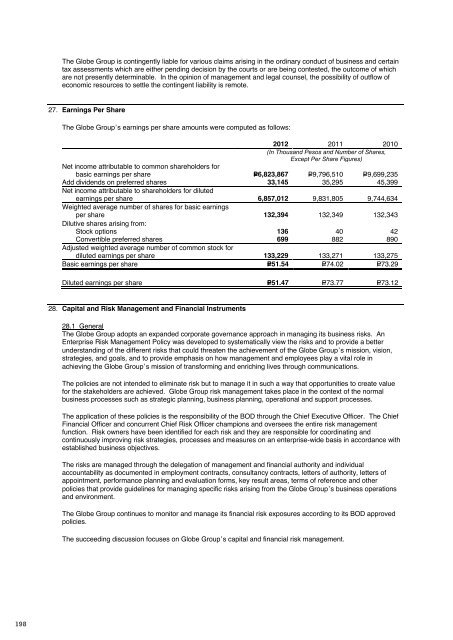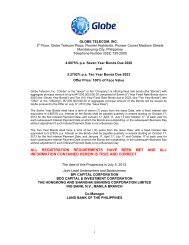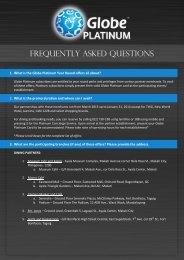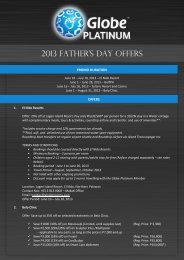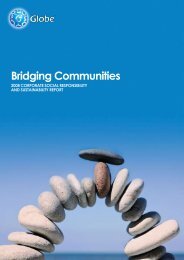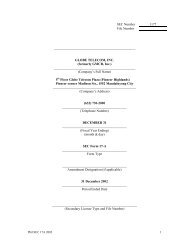Download - Globe
Download - Globe
Download - Globe
- No tags were found...
You also want an ePaper? Increase the reach of your titles
YUMPU automatically turns print PDFs into web optimized ePapers that Google loves.
<strong>Globe</strong> 2012 annual reportfinancial reportThe <strong>Globe</strong> Group is contingently liable for various claims arising in the ordinary conduct of business and certaintax assessments which are either pending decision by the courts or are being contested, the outcome of whichare not presently determinable. In the opinion of management and legal counsel, the possibility of outflow ofeconomic resources to settle the contingent liability is remote.27. Earnings Per ShareThe <strong>Globe</strong> Group’s earnings per share amounts were computed as follows:2012 2011 2010(In Thousand Pesos and Number of Shares,Except Per Share Figures)Net income attributable to common shareholders forbasic earnings per share P=6,823,867 P=9,796,510 P=9,699,235Add dividends on preferred shares 33,145 35,295 45,399Net income attributable to shareholders for dilutedearnings per share 6,857,012 9,831,805 9,744,634Weighted average number of shares for basic earningsper share 132,394 132,349 132,343Dilutive shares arising from:Stock options 136 40 42Convertible preferred shares 699 882 890Adjusted weighted average number of common stock fordiluted earnings per share 133,229 133,271 133,275Basic earnings per share P=51.54 P=74.02 P=73.29Diluted earnings per share P=51.47 P=73.77 P=73.1228. Capital and Risk Management and Financial Instruments28.1 GeneralThe <strong>Globe</strong> Group adopts an expanded corporate governance approach in managing its business risks. AnEnterprise Risk Management Policy was developed to systematically view the risks and to provide a betterunderstanding of the different risks that could threaten the achievement of the <strong>Globe</strong> Group’s mission, vision,strategies, and goals, and to provide emphasis on how management and employees play a vital role inachieving the <strong>Globe</strong> Group’s mission of transforming and enriching lives through communications.The policies are not intended to eliminate risk but to manage it in such a way that opportunities to create valuefor the stakeholders are achieved. <strong>Globe</strong> Group risk management takes place in the context of the normalbusiness processes such as strategic planning, business planning, operational and support processes.The application of these policies is the responsibility of the BOD through the Chief Executive Officer. The ChiefFinancial Officer and concurrent Chief Risk Officer champions and oversees the entire risk managementfunction. Risk owners have been identified for each risk and they are responsible for coordinating andcontinuously improving risk strategies, processes and measures on an enterprise-wide basis in accordance withestablished business objectives.The risks are managed through the delegation of management and financial authority and individualaccountability as documented in employment contracts, consultancy contracts, letters of authority, letters ofappointment, performance planning and evaluation forms, key result areas, terms of reference and otherpolicies that provide guidelines for managing specific risks arising from the <strong>Globe</strong> Group’s business operationsand environment.The <strong>Globe</strong> Group continues to monitor and manage its financial risk exposures according to its BOD approvedpolicies.The succeeding discussion focuses on <strong>Globe</strong> Group’s capital and financial risk management.28.2 Capital and Financial Risk Management Objectives and PoliciesCapital includes convertible preference shares and equity attributable to equity holders of the parent.The primary objective of the <strong>Globe</strong> Group’s capital management is to ensure that it maintains a strong creditrating and healthy capital ratios in order to support its business and maximize shareholder value.The <strong>Globe</strong> Group monitors its use of capital using leverage ratios, such as debt to total capitalization and makesadjustments to it in light of changes in economic conditions and its financial position.The <strong>Globe</strong> Group is not subject to externally imposed capital requirements. The ratio of debt to totalcapitalization for the years ended December 31, 2012, 2011 and 2010 was at 57%, 50% and 52%, respectively.The main purpose of the <strong>Globe</strong> Group’s financial risk management is to fund its operations and capitalexpenditures. The main risks arising from the use of financial instruments are market risk, credit risk andliquidity risk. The <strong>Globe</strong> Group also enters into derivative transactions, the purpose of which is to manage thecurrency and interest rate risk arising from its financial instruments.<strong>Globe</strong> Telecom’s BOD reviews and approves the policies for managing each of these risks. The <strong>Globe</strong> Groupmonitors market price risk arising from all financial instruments and regularly reports financial managementactivities and the results of these activities to the BOD.The <strong>Globe</strong> Group’s risk management policies are summarized below:28.2.1 Market RiskMarket risk is the risk that the fair value of future cash flows of a financial instrument will fluctuate becauseof changes in market prices. <strong>Globe</strong> Group is mainly exposed to two types of market risk: interest rate riskand currency risk.Financial instruments affected by market risk include loans and borrowings, AFS investments, andderivative financial instruments.The sensitivity analyses in the following sections relate to the position as at December 31, 2012, 2011 and2010. The analyses exclude the impact of movements in market variables on the carrying value of pension,provisions and on the non-financial assets and liabilities of foreign operations.The following assumptions have been made in calculating the sensitivity analyses:The statement of financial position sensitivity relates to derivatives.The sensitivity of the relevant income statement item is the effect of the assumed changes inrespective market risks. This is based on the financial assets and financial liabilities held as atDecember 31, 2012, 2011 and 2010 including the effect of hedge accounting.The sensitivity of equity is calculated by considering the effect of any associated cash flow hedges forthe effects of the assumed changes in the underlying.28.2.1.1 Interest Rate RiskThe <strong>Globe</strong> Group’s exposure to market risk from changes in interest rates relates primarily to the<strong>Globe</strong> Group’s long-term debt obligations. Please refer to table presented under 28.2.3 Liquidity Risk.<strong>Globe</strong> Group’s policy is to manage its interest cost using a mix of fixed and variable rate debt, targetinga ratio of between 31-62% fixed rate USD debt to total USD debt, and between 44-88% fixed rate PHPdebt to total PHP debt. To manage this mix in a cost-efficient manner, <strong>Globe</strong> Group enters into interestrate swaps, in which <strong>Globe</strong> Group agrees to exchange, at specified intervals, the difference betweenfixed and variable interest amounts calculated by reference to an agreed-upon notional principalamount.After taking into account the effect of currency and interest rate swaps, 31% and 59%, 39% and 58%,and 32% and 65% of the <strong>Globe</strong> Group’s USD and PHP borrowings as of December 31, 2012, 2011and 2010, respectively, are at a fixed rate of interest.198 199


